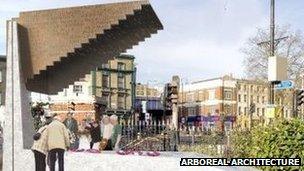Bethnal Green Tube disaster marked 70 years on
- Published
Dr Toby Butler: ''If you compare it to Hillsborough or even to Aberfan, this disaster actually had more victims''
The worst civilian disaster of World War II in Great Britain has been marked on the 70th anniversary of the Bethnal Green Tube disaster.
A total of 173 people, including 62 children, died in a crush on 3 March 1943, when people rushed to enter the station after hearing air-raid sirens.
The alarm turned out to be a test.
Hundreds of people attended the service at St John on Bethnal Green Church, east London, and then took part in a procession to the memorial.
Reporting was censored
On the night of the disaster, crowds surged after the searchlights went on and an anti-aircraft battery in nearby Victoria Park launched a salvo of a new type of anti-aircraft rocket.
It is estimated that hundreds of people fell within just 15 seconds. Unaware of what was happening in front of them, people kept surging forward into the supposed safety of the shelter.
Babette Clarke, who was 11 at the time of the disaster: "There was this horrendous noise"
Wartime morale meant reporting was censored and some accused the government of a cover up.
Singer and TV presenter Cheryl Baker gave the first reading - John Donne's No Man is an Island.
Father Alan Green, who took the service, said it was cathartic to honour the victims given the original lack of information.
He said: "The problem with the previous memorial and the cover up was the names were not publicly acknowledged so each year we have centred on reading out those names and lighting 173 candles which we place on the altar to mark those lives."
Among the names read out, the youngest was five-month-old Carol Geary.
A plaque was placed at the station in the 1990s but the first section of a new Stairway to Heaven monument has now been completed.
"With the completion of the first stage of the memorial there is a real sense of achievement of marking this for those who died and those who survived," said Mr Green.

Money is still needed to complete the permanent memorial to victims
"It [the plaque] was rather inadequate considering this disaster was worse than Hillsborough, worse than Aberfan.
"The scale of it is truly extraordinary," said Dr Toby Butler from the University of East London who is leading a project to record the memories of survivors and rescuers and the relatives of those who died.
Babette Clarke was 11 when she headed to the shelter in 1943. She said a major raid had been expected.
Missing the bus probably saved her life, she said, because she would have been among the first to enter the shelter and be crushed otherwise.
She said panic was caused when the anti-aircraft rockets were fired.
Ms Clarke said: "As they went up they whistled like the bombs did as they came down and that's what caused the pushing because people thought it was bombs coming down."
There was one small blue light and no handrails, she said.
Dr Butler said: "Most of the people that died in this disaster were women and children. It was a huge hole in the community in Bethnal Green.
"Some people still can't speak about it because it was just so incredibly traumatic."
His interviews will form part of an audio guide for visitors to the monument.
He said the Bethnal Green Memorial Trust still needs to raise about £100,000 for a canopy for the memorial.
He added: "It's going to be an incredibly important landmark in east London."
- Published3 March 2013
- Published3 March 2013
- Published5 March 2012
- Published1 March 2012